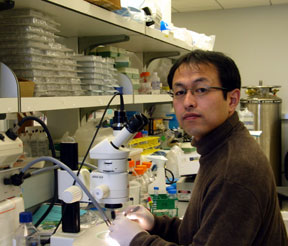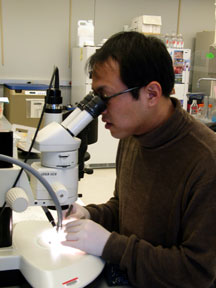 |
Jun-ichi Sakiyama, Ph.D., visits the lab of UNMC’s Claudia Kappen, Ph.D. |
Dr. Sakiyama is interested in whether the Hoxb6 gene plays a crucial role in lung development, an area he has been studying in the division of biological science at Nagoya University in Japan.
To further his research, Dr. Sakiyama spent nearly a week in the laboratory of Claudia Kappen, Ph.D., associate professor of genetics, cell biology and anatomy in UNMC’s Munroe-Meyer Institute.
There, he studied genetically engineered mice to see if lung buds are formed properly when the Hoxb6 gene is absent. Lungs develop from a structure that looks like a tube into an organ with many branches, Dr. Kappen said, but the first step is the formation of lung buds.
 Until now, Dr. Sakiyama’s research focused primarily on embryonic lung development in chickens.
Until now, Dr. Sakiyama’s research focused primarily on embryonic lung development in chickens.
“If we know which genes play a role in development, then we know how the lung normally develops and can better explain birth defects,” Dr. Kappen said. “It’s a basic science question that could in the long-run have an impact.” Esophageal atresia and tracheoesophageal fistula are two birth defects in humans that are caused by disruptions in the process of lung bud formation. The defects represent malformations of the esophagus and trachea, respectively.
Dr. Kappen created the unique mice almost 10 years ago, prior to coming to UNMC. It took three years to create the knockout, or mice that are missing a particular gene. “We are the only lab in which such mice exist, which makes them very valuable,” she said.
Dr. Sakiyama said the visit to UNMC might yield a long-term collaboration. He is a research associate in the laboratory of professor Atsushi Kuroiwa, who co-discovered homeobox genes in the early 1980s. Homeobox genes play an important role in the developmental processes of many multicellular organisms. Dr. Kappen’s lab is researching the function of homeobox genes in the development of the skeleton and the neural tube.